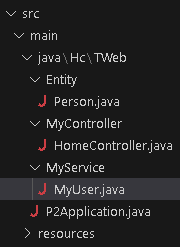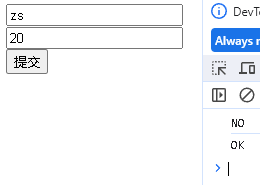js可以通过fetch方法向网络发起get和post请求;springboot可以向网络提供webapi服务。这两个基本能力,就构成了mvc结构的V和C端。c端有所扩展,就有广义的M。
本例进行简单的登录模拟。
说明:
1、用t1表结构的姓名和年龄模拟登录用的用户名和密码,没挂数据库,道理都一样。
2、登录成功和失败,返回一个简单的字符串(“OK”和“NO”)。实战中,业界通用的,应该是个JWT的票据。存储在用户端,每次发起请求的时候带上它,给服务器验证用。这个内容大家可以自己补。关于js控制页面跳转(登录后),很简单,在本博“js小应用”里有提。再不明白的,网上搜搜都有,略。
3、作为服务端,这个例子着重演示了控制器如何接收用户的get和post请求,把请求参数转化为java的形参或对象。
4、本例还带了一个MyUser的服务类,用于验证用户名密码是否通过。这是服务的雏形,也是M的种子。写多了写大了,就是大的服务和广义M。
本例开发调试的时候应该注意跨域问题。调试的时候要能调通,在生产环境要注意安全(跨域的简单和安全设置)。
实现部分
服务端:
思想:一个普通的Spring Boot Web项目(带web依赖),有一个验证提交内容是否合法的服务类MyUser,有一个接受post请求提交对象的实体类Person,一个控制器HomeController负责调度。
1、生成项目(略)

2、MyUser.java
1 package Hc.TWeb.MyService; 2 3 import org.springframework.stereotype.Component; 4 5 @Component 6 public class MyUser { 7 public boolean IsOk(String xm,String age) 8 { 9 int age1=Integer.parseInt(age); 10 if(xm.equals("zs") && age1==20) 11 { 12 return true; 13 } 14 else 15 { 16 return false; 17 } 18 } 19 public boolean IsOk1(Hc.TWeb.Entity.Person p1) 20 { 21 if(p1.xm.equals("zs") && p1.nl==20) 22 { 23 return true; 24 } 25 else 26 { 27 return false; 28 } 29 } 30 }
第5行把类注册为组件,方便自动装配。
两个方法,IsOk对两个变量做验证,IsOk1对Person类(见下面)对象做验证。
3、Person.java
package Hc.TWeb.Entity; public class Person { public String xm; public int nl; }
很简单,不说了。
4、HomeController.java
1 package Hc.TWeb.MyController; 2 3 import org.springframework.beans.factory.annotation.Autowired; 4 import org.springframework.web.bind.annotation.CrossOrigin; 5 import org.springframework.web.bind.annotation.GetMapping; 6 import org.springframework.web.bind.annotation.PostMapping; 7 import org.springframework.web.bind.annotation.RequestBody; 8 import org.springframework.web.bind.annotation.RequestParam; 9 import org.springframework.web.bind.annotation.RestController; 10 11 import Hc.TWeb.MyService.MyUser; 12 import Hc.TWeb.Entity.*; 13 14 @RestController 15 @CrossOrigin 16 public class HomeController { 17 @Autowired 18 MyUser myuser; 19 20 @GetMapping("/login") 21 public String MyLogin(@RequestParam(value = "xm") String a,@RequestParam(value = "nl") String b) 22 { 23 if(myuser.IsOk(a, b)) 24 { 25 return "OK"; 26 } 27 else 28 { 29 return "NO"; 30 } 31 } 32 @PostMapping("/login1") 33 public String MyLogin1(@RequestBody Person p) 34 { 35 if(myuser.IsOk1(p)) 36 { 37 return "OK"; 38 } 39 else 40 { 41 return "NO"; 42 } 43 } 44 }
代码很简单,对注解进行简单说明:
第14行,说明整个类是控制器,返回复杂类型的时候,直接转换成json格式。
第15行,跨域。
第17行,myuser自动装配(不用new)
第20行和第32行,对指定请求方式(get/post)括号里的url进行拦截,执行对应方法。
第21行的注解,表示这两个参数来自url里的参数(即"?"后面的部分)。这些参数都会被识别为字符串,所以形参b的类型是String。
第33行的注解,表示对象参数p来自于请求体(post过来的内容,按属性对应,自动转换)。
以上即后端,很简单。
前端:一个页面一个js,模拟两种提交,并在浏览器控制台查看结果。
页面index.html:
<!DOCTYPE html> <html> <head> <meta charset="utf-8" /> <title></title> <script src="js/j1.js"></script> </head> <body> <!--form action="http://192.168.1.125:8080/login"--> <input type="text" id="xm"/><br /> <input type="text" id="nl"/><br /> <input type="button" value="提交" onclick="sub_query()"/> <!--/form--> </body> </html>
很简单,不解释。
j1.js:
思路:取出控件,用里面的值拼成请求,发送,输出结果。
1 function sub_query() { 2 x = document.querySelector("#xm"); 3 y = document.querySelector("#nl"); 4 // z = "http://192.168.1.125:8080/login?xm=" + x.value + "&nl=" + y.value; 5 // fetch(z) 6 // .then(r => r.text()) 7 // .then(r => console.log(r)); 8 9 z = "http://192.168.1.125:8080/login1"; 10 mydata = JSON.stringify({ 11 xm: x.value, 12 nl: parseInt(y.value) 13 }); 14 //console.log(mydata); 15 //return; 16 fetch(z, { 17 method: "post", 18 headers: new Headers({ 19 'Content-Type': 'application/json' 20 }), 21 body: mydata 22 }).then(r => r.text()) 23 .then(r => console.log(r)); 24 }
说明:4-7行为get方式提交内容;后面为post方式提交;14、15行调试用。
调试:先启动后端,再启动前端测试。主机位置可以用ip地址。

本例做完之后,应好好体会JavaEE项目开发里各个知识点的贯穿。
(完)



 浙公网安备 33010602011771号
浙公网安备 33010602011771号